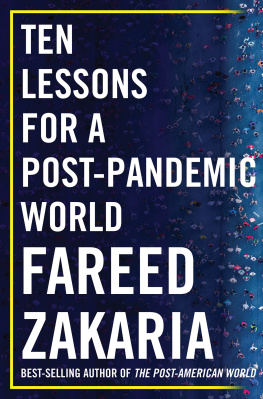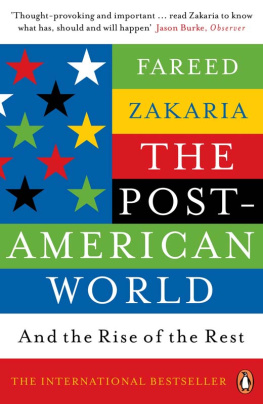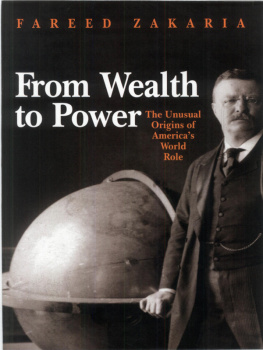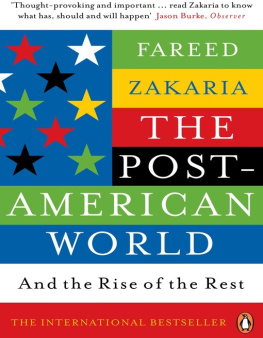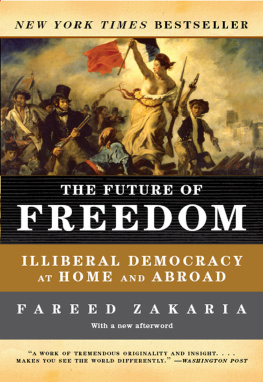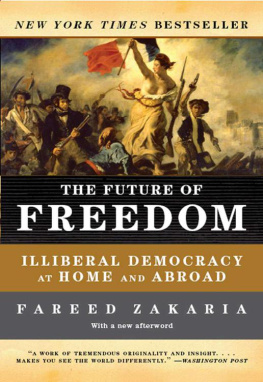Fareed Zakaria - Ten Lessons for a Post-Pandemic World
Here you can read online Fareed Zakaria - Ten Lessons for a Post-Pandemic World full text of the book (entire story) in english for free. Download pdf and epub, get meaning, cover and reviews about this ebook. year: 2020, publisher: W. W. Norton & Company, genre: Politics. Description of the work, (preface) as well as reviews are available. Best literature library LitArk.com created for fans of good reading and offers a wide selection of genres:
Romance novel
Science fiction
Adventure
Detective
Science
History
Home and family
Prose
Art
Politics
Computer
Non-fiction
Religion
Business
Children
Humor
Choose a favorite category and find really read worthwhile books. Enjoy immersion in the world of imagination, feel the emotions of the characters or learn something new for yourself, make an fascinating discovery.
- Book:Ten Lessons for a Post-Pandemic World
- Author:
- Publisher:W. W. Norton & Company
- Genre:
- Year:2020
- Rating:3 / 5
- Favourites:Add to favourites
- Your mark:
- 60
- 1
- 2
- 3
- 4
- 5
Ten Lessons for a Post-Pandemic World: summary, description and annotation
We offer to read an annotation, description, summary or preface (depends on what the author of the book "Ten Lessons for a Post-Pandemic World" wrote himself). If you haven't found the necessary information about the book — write in the comments, we will try to find it.
Ten Lessons for a Post-Pandemic World — read online for free the complete book (whole text) full work
Below is the text of the book, divided by pages. System saving the place of the last page read, allows you to conveniently read the book "Ten Lessons for a Post-Pandemic World" online for free, without having to search again every time where you left off. Put a bookmark, and you can go to the page where you finished reading at any time.
Font size:
Interval:
Bookmark:

Ten Lessons for a
Post-Pandemic World
FAREED ZAKARIA

W.W. NORTON & COMPANY
Independent Publishers Since 1923
Ten Lessons for a
Post-Pandemic World
T HE NEW YORK TIMES called it the spiky blob seen around the world. In late January, Alissa Eckert and her colleague Dan Higgins at the Centers for Disease Control and Prevention were tasked with creating an illustration of the novel coronavirus. What was needed was something to grab the publics attention, Eckert later explained to the Times. What they produced was an image of a silvery globe with bright crimson spikes. It was evocative and disturbing, and it was soon everywhere, appearing in newspapers, magazines, and on television news. If right now you are imagining what a coronavirus looks like, then chances are you are thinking of the Eckert-Higgins rendering or a derivation of it. In the slightly macabre world of professional medical artists, the picture is known as a beauty shot, an up-close depiction of a single viral particle, making it look menacing but also massive. In fact, the novel coronavirus is about 1/10,000th the size of the period that ends this sentence.
We are often advised to think big. But maybe we need to start thinking small. Were good at imagining the big, traditional dangers we face, however unlikely they have become, such as military attacks and invasions, and planning large-scale symmetrical responses to them. Governments spend trillions of dollars to build vast militaries, track the movement of armies across the planet, and practice war games against potential foes. The United States alone devotes almost three-quarters of a trillion dollars to its defense budget every year. And yet, we were unprepared to defend against a tiny microbe. It may well turn out that this viral speck will cause the greatest economic, political, and social damage to humankind since World War II.
This is a book not about the pandemic, but rather about the world that is coming into being as a result of the pandemic andmore importantlyour responses to it. Any large shock can have diverse effects, depending on the state of the world at the time and on how human beings reactwith fear or denial or adaptation. In the case of the novel coronavirus, the impact is being shaped by the reality that the world is deeply interconnected, that most countries were unprepared for the pandemic, and that in its wake, many of themincluding the worlds richest nationsshut down their societies and economies in a manner unprecedented in human history.
This book is about a post-pandemic world not because the coronavirus is behind us, but because we have crossed a crucial threshold. Almost everyone alive had been spared from experiencing a plague, so far. But now we know what a pandemic looks like. We have seen the challenges and costs of responding to it. The Covid-19 pandemic could persist, but even if it is eradicated, new outbreaks of other diseases are almost certain to occur in the future. With this knowledge and experience, we now live in a new era: post-pandemic.
What exactly are the consequences of this pandemic? Some have suggested that it will prove to be the hinge event of modern history, a moment that forever alters its course. Others believe that after a vaccine, we will quickly return to business as usual. Still others argue that the pandemic will not reshape history so much as accelerate it. This last scenario seems the most likely outcome. Lenin is supposed to have once said, There are decades when nothing happens, and then there are weeks when decades happen. The post-pandemic world is going to be, in many aspects, a sped-up version of the world we knew. But when you put life on fast-forward, events no longer proceed naturally, and the consequences can be disruptive, even deadly. In the 1930s, many developing countries were modernizing at a steady pace, moving people from agriculture to industry. The Soviet Union decided to brutally accelerate that process. This decision, the collectivization of agriculture, led to famine, the liquidation of millions of farmers, a hardening of dictatorship, and the deformation of Soviet society. A world on steroids can suffer unpredictable side effects.
Post-pandemic life will be different for countries, companies, and especially individuals. Even if economics and politics return to normal, human beings will not. They will have been through an unusual, difficult trial and have a sense of newfound, hard-won opportunity. Having survived the Spanish flu, a character in William Maxwells 1937 novel, They Came Like Swallows, feels a sense of wonder clinging to him (for it had been a revelation: neither he nor anyone else had known that his life was going to be like this). As the worst passes, we emerge into the dead cold light of tomorrow, as the writer Katherine Anne Porter put it in her 1939 semi-autobiographical novella, Pale Horse, Pale Rider, about surviving the same pandemic. Her last line: Now there would be time for everything.
PLAGUES HAVE CONSEQUENCES
We should have seen it coming. The coronavirus may be novel but plagues are not. Western literature begins with one. In the opening verses of Homers Iliad, the Greek armies are being ravaged by pestilence. It turns out to be divine punishment directed at their leader, the vain, avaricious, and quarrelsome King Agamemnon. The first serious history written in the West hinges on a plague. Thucydides History of the Peloponnesian War chronicles the long conflict between the two superpowers of the age, Athens and Sparta. Toward the beginning of the war, Thucydides writes, a terrible plague swept through Athens, killing vast numbers of able-bodied citizens and, most significant, the city-states peerless leader, Pericles. The two sides had very different political systems: Athens was democratic, Sparta a more rigidly run warrior society. Sparta eventually prevailed, and its not a stretch to say that, had there been no plague, Athens might have won, and the course of Western history would have been differentwith a vibrant democracy becoming a successful role model rather than a flame that burned brightly, but then flickered out. Plagues have consequences.
The most consequential by far was the bubonic plague, which began in Central Asia in the 1330s and spread to Europe in the following decade. One medieval chronicler accused the Mongols of introducing the disease to the continent by launching plague-ridden corpses into a Genoese fortress by catapultan early bioweapon. More likely, the plague spread through global commerce, borne by the caravans and ships that plied goods from the Orient to major ports like Messina in Sicily and Marseilles in France. Also called the Black Death, it was carried by fleas on the backs of rats and attacked the lymphatic system of its victims, causing suffering and death on a scale that has never been seen since. Up to half of Europes population was wiped out. The disease, like many, was never fully eradicated. The World Health Organization still reports a few hundred cases of bubonic plague every year, luckily now treatable with antibiotics.
The bubonic plague had seismic effects. Scholars believe that with so many dead, the economics of the time was turned on its head. Walter Scheidel explains that labor became scarce and land abundant, so wages rose and rents fell. Workers won more bargaining power and nobles lost out. Serfdom withered away in much of Western Europe. Of course, the impact varied from country to country based on each ones economic and political structures. Inequality actually rose in some places that took repressive measures. For example, noble landlords in Eastern Europe used the misery and chaos to tighten their hold and impose serfdom for the first time. Beyond these material effects, the plague prompted an intellectual revolution. Many fourteenth-century Europeans asked why God would allow this hell on earth and questioned entrenched hierarchieswhich had the ultimate effect of helping Europe break out of its medieval malaise and setting in motion the Renaissance, Reformation, and Enlightenment. From death and horror came science, modernity, and growth. With Covid-19, thankfully, we do not face the same mass mortality. But might our eras pandemic provoke a similar spirit of societal introspection, an equivalent shock to our complacency?
Next pageFont size:
Interval:
Bookmark:
Similar books «Ten Lessons for a Post-Pandemic World»
Look at similar books to Ten Lessons for a Post-Pandemic World. We have selected literature similar in name and meaning in the hope of providing readers with more options to find new, interesting, not yet read works.
Discussion, reviews of the book Ten Lessons for a Post-Pandemic World and just readers' own opinions. Leave your comments, write what you think about the work, its meaning or the main characters. Specify what exactly you liked and what you didn't like, and why you think so.

